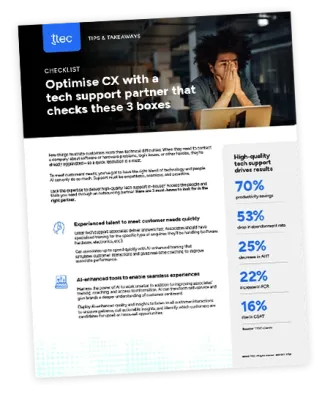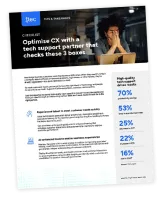There’s no overstating the importance of having high-quality contact centres. These centres are often where customers interact with a brand more directly, and their experiences can bring swift consequences: positive experiences can lead to sales and repeat business, while negative ones can turn customers off a brand for good.
Research shows 70% of shopping experiences revolve around how a person feels they are treated. In this respect, contact centres are on the front lines. But when it comes to captive centres vs. outsourced ones, which is the best way to take customer service and sales to the next level?
Captive centres, those that are client owned and operated, provide resources directly to their organisation. The associates working in the centres are employed by the company, not a vendor. This may seem like an attractive option for brands that want to retain control of centre operations, and ensure all associates remain on-brand and embrace the corporate culture.
But, in the captive centre vs. outsourcing debate, there are compelling reasons to choose outsourcing.
Hiring the Right People
These days, more is expected of service and sales associates than ever before. Today’s workforce must possess complex problem-solving skills, excel in people management, coordinate well with others, and have high emotional intelligence. In an era when so many simple tasks are being handled by AI, the complex problems are left to the people – so finding the right ones is key.
Finding contact centre employees with the right skillset can be difficult for brands to do efficiently. But an outsource partner, which has experience and expertise in this area, can take the burden off the brand so that it can focus on its core business mission.
With the right associates, everybody wins: employees feel empowered to make decisions that benefit both customers and the company, customers have positive experiences, and companies’ bottom lines will benefit as a result.
Becoming More Efficient
Business takes place in the global marketplace 24/7 these days, and customers expect to be able to access brands whenever it’s convenient for them. This means companies must be ready to offer support at any time, on any channel, in any language. Associates who don’t meet these expectations risk a frustrating and disconnected experience.
While this can be challenging for a captive centre, a benefit of outsourcing vs. captive centres is that an outsource partner has resources around the world – with physical space, technology and staff at the ready. Partner experts know how to act quickly and move to the next objective. Tasks get completed faster and more efficiently.
Faster and More Effective Training
When closing sales, speed and efficiency are the names of the game. An outsourcer can help you get there by training more contact centre associates faster and more effectively. Well-versed in industry best practices, outsourcers are equipped to use the latest technology to boost productivity and bottom lines – like TTEC’s RealPlay Bot, which lets associates practice with and get real-time feedback from a bot that acts like an AI-powered customer.
An outsourcer can work to make sure employees are motivated and equipped with the right skills to deliver great customer service experiences during each interaction. In giving the right tools and training, they help brands build a workforce that is competent, collaborative and connected.
Tapping into Expertise
Too often, customer service serves a secondary function because brands are so focused on their products and services. This doesn’t bode well for those brands since, more and more, customers are looking to customer experience as a differentiator, even ahead of products and price in some cases.
The right outsource partner, on the other hand, lives and breathes customer experience. They specialize in end-to-end CX capabilities, can leverage digital and next-gen strategies, provide operations rigor, and hire and retain world-class associates who serve as brand ambassadors.
The expertise a brand may lack in-house can be found in the right partner.
Optimising Digital
Not surprisingly, digital plays a strong role in contact centre success. Another difference between captive centres vs. outsourced ones is that outsourcing partners can give brands the digital edge.
Customers want more digital and technology options, meaning brands must provide multiple channels of support. Not only that, but they also need to understand which channels work best for various types of interactions.
A strong grasp on AI, in particular, is becoming increasingly important; Gartner predicts that this year 15% of all customer service interactions will be completely handled by AI, a 400% percent increase since just 2017.
A captive centre may make sense for organisations with low customer support volume and simple customer requests. For organisations that seek to differentiate themselves with a great customer experience, working with an experienced partner is key.
The right partner will bring expertise and tech know-how in digital channels, and balance people with technology in a cost-effective manner – all in a way that frees brands up to focus on their core business mission.
To learn more about choosing the right outsourcing partner, here are additional resources:
Sales Outsourcing: 11 Benefits to Outsourcing Sales: Among its many benefits, sales outsourcing can help brands tap into underserved markets, leapfrog technology constraints, break out of silos, and overcome other obstacles.
4 Questions to Decide if Contact Centre Outsourcing is Right for You: When done right, contact centre outsourcing is an opportunity to gain specialized knowledge and resources, along with other benefits. But not every organisation needs a contact centre partner. Does yours?
Agile Outsourced Support from Day One: A global payments technology provider that was new to outsourced support, needed a trusted partner that would be an extension of its brand and provide customers with care that was seamless and agile.
From Outsourcing to Orchestration: We discuss how outsourcing is changing from a simple, transactional thing into something a lot more sophisticated - something more like orchestration.














